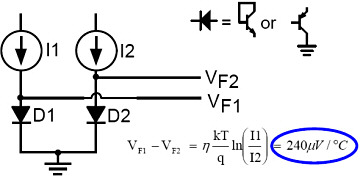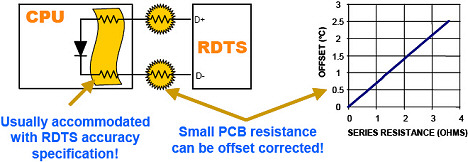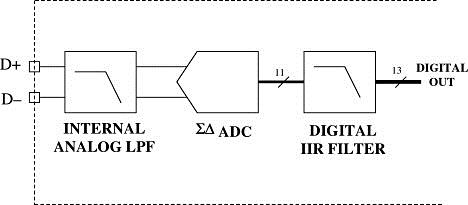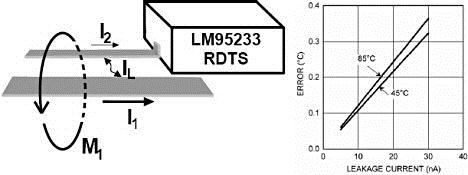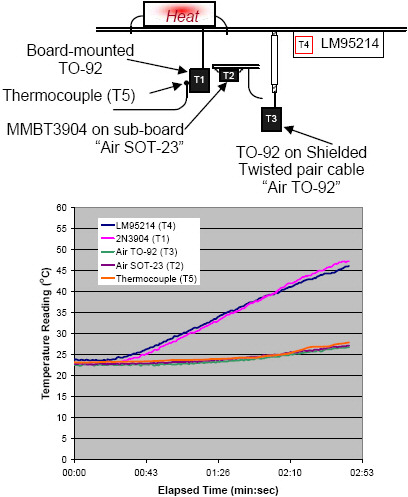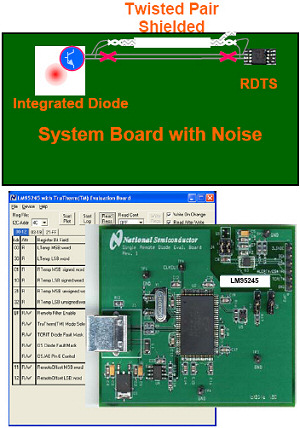Looking to improve your temperature sensor measurement in a cost effective manner?
Since 1965, Thermometrics Corporation has been dedicated to furnishing the industrial community with a smart, yet simple, cost effective solution to temperature measurement. Thermometrics is a manufacturer of analog and digital temperature sensors, RTD's, thermocouples, thermowells, sanitary sensors and accessories for Pharmaceutical, Aerospace, Marine, Petro-Chemical, Food Processing and Utilities.
Temperature Sensor Tips and Tricks
January 1, 2008 By: Emmy Denton, National Semiconductor Corp. Sensors
When you're adding temperature sensors to a PCB, correct placement can make all the difference. Here are some tips and tricks to place your sensors effectively.
Positioning temperature sensors on a PCB presents a number of difficulties. Thermal gradients between the sensor and the temperature point being measured can often cause errors, and troubleshooting digital and analog noise sources can be extremely difficult. With IC temperature sensor signal levels in the microvolt or millivolt range, good layout techniques are imperative.
This article focuses on remote diode temperature sensors (RDTS), which are used to monitor diode junction(s) in a highly integrated, power-hungry device such as a processor. Having the sensor on the die eliminates the need for the kinds of costly assembly techniques required to measure case temperature. The sensor can also monitor the junction temperature of a bipolar transistor, such as the common 2N3904/MMBT3904. An RDTS with a multiplexer front end can be a cost-effective way to enable several temperature sensing nodes for a system; the implementation techniques discussed may also be applied to other analog or digital IC temperature sensors.
To understand the error sources and how to overcome them, here is a brief high-level description of integrated sensors. Figure 1 shows a simplified circuit that lies at the core of most integrated temperature sensors (analog or digital), with bipolar NPN or PNP transistors as the diodes. The standard equation for the base emitter voltage drop of a bipolar transistor, as described by the Ebbers-Moll transistor model, includes a reverse saturation current (Is) term that exhibits device to device variation. You can use a single-current method if accuracy is not critical (4°C–8°C).
|
|
To cancel out the Is term, we use a two-current method, as shown in Figure 1. In the actual model, the required parameter is the current density of the base emitter junction but this is simplified in the diagram by making the geometry of the two diodes identical, and by scaling the current through the diodes. Our example assumes a 16:1 current ratio applied to the diodes. This circuit allows a single differential measurement that helps cancel noise appearing on the diode, improving the circuit's noise performance. Because remote diode sensors have only one available diode, two differential measurements are taken at consecutive time intervals, which are then subtracted out to give a signal level of about 240 µV/°C. The time difference in the measurements does not provide the same noise immunity as that obtained using a single differential measurement but it is still acceptable.
The assumption used by most traditional temperature sensors is that the current forced by the RDTS (the emitter current) is the same as the base current. While this is true for remote diodes with high betas or very small beta variation (the ratio of the transistor's collector current to its base current) it isn't true when the sensing diode is integrated into power-hungry devices with high-density integration, such as processors and FPGAs—available today in 90 nm and smaller geometries. Thermal diodes on sub-micron geometries such as 90 nm, 60 nm or 45 nm have very low betas. To overcome this, several manufacturers have released RDTS devices that support bipolar transistor junction(BTJ))/transistor beta compensation, such as National's TruTherm technology. The performance of these parts varies widely, so examine the specifications carefully.
PCB layout considerations
The major offenders against analog signal integrity on a PCB are EMI, thermocouple effects, trace resistance, and PCB leakage current. Digital signal integrity is mainly affected by trace length and impedance at the frequency of operation.
Dealing with trace (series) resistance. The board designer should make his best effort to minimize series resistance because the higher the trace impedance, the greater the likelihood that noise coupling will become an issue. To further mitigate series resistance, RDTS devices have internal compensation circuitry. A digital register that allows you to program an offset for the temperature reading reported by the device is fairly common and can be used to compensate for series resistance. The series resistance has a linear function for a specific sensor (Figure 2) because the input stages of most RDTS devices can handle the common-mode offset caused by several ohms of series resistance.
|
|
Some RDTS devices implement series resistance cancellation but this method introduces more noise in the overall temperature reading. Devices without series resistance cancellation take the difference between two diode voltage readings at different current levels. Canceling out series resistance is commonly achieved by introducing another current level and another diode voltage measurement. However, the voltage measurements do not happen simultaneously, making noise cancellation more difficult.
Dealing with noise. The first defense against noise issues is the circuitry within the RDTS itself. As shown in Figure 3, the analog front end, ADC architecture, and additional digital filtering on the die all play a part in ensuring a stable, noise-free temperature reading. Most sensors include an analog filter at the pins of the RDTS. Some implement a ΣΔ (sigma-delta) ADC, which includes a digital filter for first-stage averaging that is absent in successive approximation (SAR) ADCs. The final stage of defense is a digital filter included in most RDTS devices and commonly called a digital smoothing filter. Because there are product differences among manufacturers, take the time to examine the device datasheets carefully.
|
|
Good layout is always important, especially when signal levels get down to the 240 µV/°C level. Even if you're dealing with analog sensors that have 10 mV/°C sensitivity, the signal level is still small and you still need to be careful. In digital environments, where noise levels can be many hundreds of millivolts, it's important to keep the analog traces separated from the digital circuitry and digital traces: watch out for inductive coupling between traces on the PCB. Avoid routing a digital trace in parallel with the analog trace. Should the digital trace need to cross the analog trace make sure the two traces are perpendicular. Guard the analog traces to avoid noise coupling by using proper power supply bypass capacitors and following the manufacturer's suggestions. Without proper bypassing, improperly compensated bond wire inductance can induce noise in digital sensors.
A poorly chosen bypass capacitor can result in the PCB leaking current to the diode traces while improper cleaning procedures also can cause errors in the temperature readings of remote diode sensors (Figure 4). In the figure, 20 nA of leakage can cause more than 0.2°C of error.
|
|
EMI is too broad a topic to be covered here but there are many good sources of information available. Thermocouple effects are negligible if the layout is limited to a few copper/solder joints and the signal level is in the sub-microvolts.
Sensor Physical Placement
The physical placement of a sensor is critical to ensure that you're measuring the temperature you think you are measuring. The curve in Figure 5 shows the performance of the 2N3904/MMBT3904 transistor mounted in various ways to measure air temperature. The board-mounted throughhole 2N3904 (T1) does not actually measure the air temperature even though the package was mounted off the board, as far away as the leads would allow, because the leads have a very good thermal conductive path to the sensor. This is good if you want to measure the board temperature but bad if you're trying to measure the ambient air temperature. Better alternatives are shown with the transistors marked T2 and T3. T2 is placed on a PCB off the main board. T3 is placed off the main PCB at the end of a twisted-pair shielded cable. T4 measures the local temperature as sensed by a National Semiconductor LM95214 quad input RDTS. The LM95214 can sense the temperature of four remote diodes as well as its own junction temperature (T4). If we compare the performance of T1 through T4 we get the curve shown in Figure 5. A simple power resistor in a stagnant air environment provided heat on the back side of the board. As the resistor heats up so does the temperature of the board-mounted 2N3904 (T1) and LM95214 (T4). We used a thermocouple as a reference measurement of the air temperature. The shielded twisted-pair cable can be extended for many feet, but if this is the case, take care to limit the capacitance to the RDTS manufacturer's recommendations and choose the gauge of the wire to minimize series resistance.
|
|
Troubleshooting Remote Diodes in a Noisy Environment
In a system with many components, noise can come from a variety of sources, making isolation of the noise source difficult. Here is a simple debugging technique that determines the noise source using an evaluation board available from most RDTS semiconductor vendors. Figure 6 shows National Semiconductor's LM95245 RDTS evaluation platform that is supplied with SensorEval software, which allows access to the registers of the RDTS via a USB connection. The evaluation board is powered off the USB bus, making the overall connection even simpler. The procedure is simple:
· Lift pins of the RDTS or cut the traces and patch in the evaluation board diode connection into the system to determine whether the PCB routing is ok to the sensor and if the issue is caused by the power supply or other source
· Alternatively, you can cut the traces between the RDTS and the integrated diode and replace the connection with shielded twisted-pair cable (for noise immunity) to determine whether the issue may be caused by the actual routing on the PCB
|
|
You can compensate for most error sources, but not for all of them. You'll get the best results if you specify a sensor with built-in noise immunity and follow proper layout techniques. Make sure to mount the sensor properly so the target temperature zone or device is sensed properly, and be aware of the sensor's surroundings.

